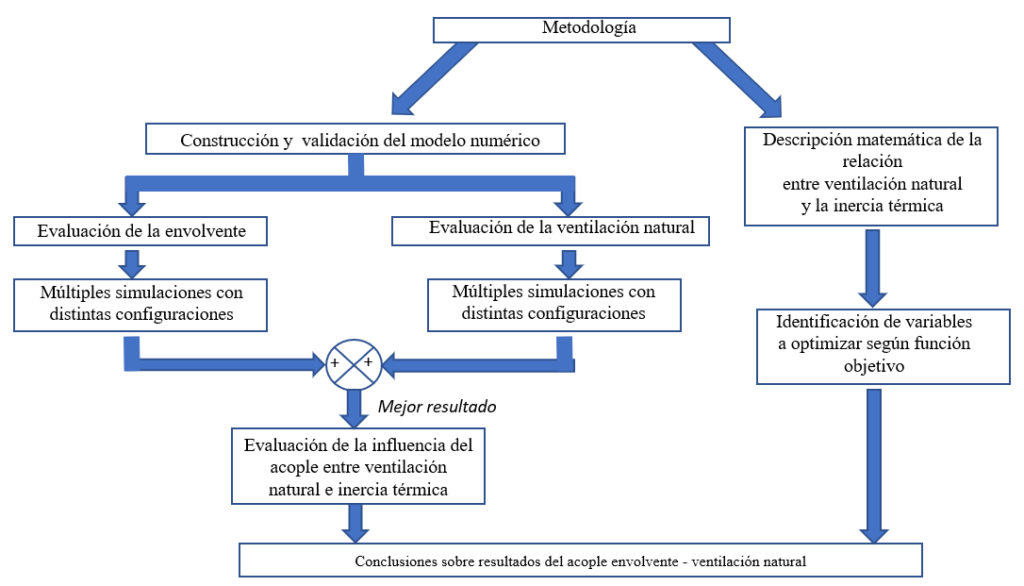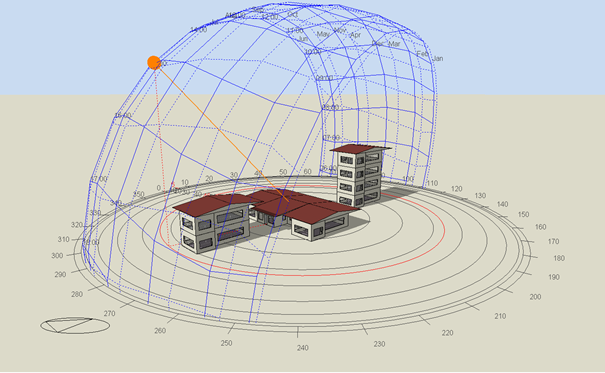Tesis de licenciatura en Ingeniería Electromecánica
Estudiante: Jesús Harmodio Araúz Sarmiento
Dirección:
- Dra. Dafni Mora (Asesora)
- Dr. Miguel Chen Austin (Co-asesor)
Resumen:
La eficiencia energética en las edificaciones representa un punto de gran importancia para la sostenibilidad global de un país y su respuesta ante los problemas climáticos y energéticos existentes. Es por eso que, en el presente trabajo de investigación, se procura analizar térmicamente una edificación residencial sencilla desde el punto de la vista de la envolvente y su relación con la ventilación natural. El modelado de una edificación permite entender cómo se comporta cada parte de un sistema ante las temperaturas del medio que la rodea y, asimismo, decidir apropiadamente la composición de los materiales de construcción y permite recomendar comportamientos para los habitantes de ésta. De acuerdo con las características meteorológicas de Panamá, se observó que la edificación no es capaz de lograr confort térmico por sí misma (sistemas mecánicos inactivos), situación aplicable a la mayoría de las edificaciones nacionales debido a la similitud de materiales de construcción y dimensiones convencionales de éstos. Luego del análisis posterior, se procedió a modificar las partes de la envolvente que más aportan al calentamiento del recinto, lo cual permitió alcanzar una sensación térmica dentro del rango del confort térmico establecido por la norma UNE-ISO-7730. Para saber que partes de la envolvente modificar, se realizó un análisis horario de las ganancias de calor de la envolvente y se modificó el horario de apertura de las ventanas en pro de maximizar el efecto de la ventilación natural. Sin embargo, lo anterior no permitió mejorar considerablemente el confort, posiblemente debido a la ubicación de las ventanas sobre la envolvente. Las modificaciones de la envolvente no solamente proporcionaron mejores condiciones internas, sino que también homogenizaron el comportamiento térmico global de la edificación; facilitando su modelado fisicomatemático y reduciendo la capacidad de computación requerida para solucionar el sistema de ecuaciones representativo.
Objetivo general:
Determinar el acople óptimo entre la ventilación natural y la modificación de la envolvente teniendo en cuenta el confort interior y el consumo energético.
Publicaciones asociadas:
- Towards nearly zero energy buildings in Panama through low-consumption techniques: A numerical study. Dafni Mora, Jesús Araúz, Miguel Chen Austin. 74th Congreso Anual de la Asociación Termotécnica Italiana (ATI). Septiembre 2019. AIP Conference Proceedings 2191, 020114 (2019) https://aip.scitation.org/doi/abs/10.1063/1.5138847
- Impact of the Envelope Layout in the Thermal Behavior of Buildings in Panama: A Numerical Study. Jesús Araúz, Dafni Mora, Miguel Chen Austin. 7th international Engineering Sciences and Technology Conference 2019. Panamá, Panamá. Octubre 2019. https://ieeexplore.ieee.org/document/8943584
Duración total:
Duración neta:
Metodología:

Edificación:

Referencias bibliográficas:
[1] Acciona, “TOP 5 PAÍSES EN ENERGÍAS RENOVABLES.” [Online]. Available: https://www.sostenibilidad.com/energias-renovables/top-5-paises-energias-renovables/.
[2] Centro Nacional de Despacho (CND), “Oferta Nacional,” Panamá, Panamá, 2019.
[3] Secretaría Nacional de Energía (SNE), “Cuadro de Sistemas Aislados Capacidad de Unidades por Empresa.” Panamá, 2018.
[4] Empresa de Transmisión Eléctrica S.A, “Centro Nacional de Despacho: documentos,” 2019. [Online]. Available: http://www.cnd.com.pa/index.php.
[5] Empresa de Transmisión Eléctrica S.A, “Centro Nacional de Despacho: documentos,” 2019. [Online]. Available: http://www.cnd.com.pa/documentos.php?page=9.
[6] Agencia Internacional de Energías Renovables (IRENA), “Evaluación del estado de preparación de las energías renovables: Panamá,” 2018.
[7] Secretaria Nacional de Ciencia y Tecnología (SENACYT), “Plan Estratégico Nacional de Ciencia, Tecnología e Innovación 2015-2019.”
[8] Gaceta Oficial, Guía de construcción sostenible para el ahorro., no. 28165. Panamá, 2016, pp. 1–57.
[9] A. Syed, Advanced building technologies for sustainability. Hoboken, New Jersey, 2012.
[10] H. Grandos, Principios y estrategias del diseño bioclimático en la arquitectura y el urbanismo, eficiencia energética. Madrid, España, 2006.
[11] A. Baño, “La arquitectura bioclimática: términos nuevos, conceptos antiguos. Introducción al diseño de espacios desde la óptica medioambiental.,” Dpto. de Arquitectura de la Universidad de Alcalá. España, p. 23, 2011.
[12] L. Peréz, J. Ortiz, and C. Pout, “A review on buildings energy consumption information ´,” Energy & Buildings, vol. 40, pp. 394–398, 2008.
[13] O. El-anwar et al., “Civil Engineering Grand Challenges : Opportunities for Data Sensing , Information Analysis , and Knowledge Discovery,” Computing in Civil Engineering, pp. 1–14, 2014.
[14] A. Ahmad et al., “A review on applications of ANN and SVM for building electrical energy consumption forecasting,” Renewable and Sustainable Energy Reviews, vol. 33, pp. 102–109, 2014.
[15] C. K. Mytafides, A. Dimoudi, and S. Zoras, “Transformation of a university building into a zero energy building in Mediterranean climate,” Energy & Buildings, vol. 155, no. 2017, pp. 98–114, 2020.
[16] S. B. Sadineni, S. Madala, and R. F. Boehm, “Passive building energy savings : A review of building envelope components,” Renewable and Sustainable Energy Reviews, vol. 15, no. 8, pp. 3617–3631, 2011.
[17] M. P. Mazzocco, C. Filippín, H. Sulaiman, and S. F. Larsen, “Performance energética de una vivienda social en Argentina y su rehabilitación basada en simulación térmica TT – Energy performance of a social dwelling in Argentina and its retrofitting based on thermal simulation,” Ambiente Construído, vol. 18, no. 4, pp. 215–235, 2018.
[18] S. Mengjie, N. Fuxin, M. Ning, H. Yanxin, and D. Shiming, “Review on building energy performance improvement using phase change materials,” Energy & Buildings, vol. 158, pp. 776–793, 2018.
[19] J. Zhou, G. Zhang, Y. Lin, and Y. Li, “Coupling of thermal mass and natural ventilation in buildings,” vol. 40, pp. 979–986, 2008.
[20] P. F. Linden, “THE FLUID MECHANICS.” California, 1999.
[21] A. Walker, “Natural Ventilation,” 08-02-2016, 2016. [Online]. Available: http://www.wbdg.org/resources/natural-ventilation?r=env_wall_eifs.
[22] C.-A. Roulet, Santé et qualité de l’environnement intérieur dans les bâtiments. Science et ingénierie de l’environnement, 2010.
[23] H. Montazeri, “Experimental and numerical study on natural ventilation performance of various multi-opening wind catchers,” Building and Environment, vol. 46, no. 2, pp. 370–378, 2011.
[24] C. López and D. Sierra, “Arquitectura colonial de Colombia : la casa patio en Cartagena de Indias y Bogotá. Bioclimatic conditioners in the colonial architecture of Colombia : the house-yard in.,” vol. 7, pp. 7–18, 2018.
[25] G. Evola and V. Popov, “Computational analysis of wind driven natural ventilation in buildings,” vol. 38, pp. 491–501, 2006.
[26] P. Heiselberg, “Design Principles for Natural and Hybrid Ventilation,” Aalborg Universitet, p. 15, 2000.
[27] J. Roucoult, O. Douzane, and T. Langlet, “Incorporation of thermal inertia in the aim of installing a natural nighttime ventilation system in buildings,” pp. 129–133, 1999.
[28] G. D. I. Vicens, S. S. Castro, and R. Vicente, “Sobre inercia térmica y aislamiento de viviendas en clima cálido-húmedo. On thermal inertia and insulation of buildings in warm-humid climate.,” vol. 4, pp. 14–26, 2018.
[29] M. Chen Austin, “On the coupling between natural ventilation and sensible energy charge and discharge in buildings : an experimental and modeling approach,” L’UNIVERSITÉ DE BORDEAUX, 2018.
[30] S. A. Zaki, S. A. Damiati, H. B. Rijal, A. Hagishima, and A. A. Razak, “Adaptive thermal comfort in university classrooms in Malaysia and Japan,” Building and Environment, 2017.
[31] World Bank Group, “Global Solar Atlas,” 2019, 2019. [Online]. Available: https://globalsolaratlas.info/?c=1.911757,46.694041,2&m=sg:gti.
[32] A. Nedhal, “The Effects of Orientation , Ventilation , and Varied WWR on the Thermal The Effects of Orientation , Ventilation , and Varied WWR on the Thermal Performance of Residential Rooms in the Tropics,” Sustainable Development, no. May 2014, p. 9, 2011.
[33] W. Tian, “A review of sensitivity analysis methods in building energy analysis,” no. June, 2018.
[34] T. Méndez, A. Capozzoli, Y. Cascone, and M. Sassone, “The early design stage of a building envelope : Multi-objective search through heating , cooling and lighting energy performance analysis,” APPLIED ENERGY, vol. 154, pp. 577–591, 2015.
[35] M. Haase and A. Amato, “An investigation of the potential for natural ventilation and building orientation to achieve thermal comfort in warm and humid climates,” Solar Energy, vol. 83, no. 3, pp. 389–399, 2009.
[36] V. Olgyay, Design with Climate: Bioclimatic Approach to Architectural Regionalism, New and ex. New Jersey, USA: Princeton University Press, 2015.
[37] D. Rilling, S. H. Siang, and S. H. Siang, “Thermal simulation as design tool for residential buildings in Southeast Asia,” Alam Bina, no. October, p. 54, 2015.
[38] H. Uysal and R. Demirbog, “The effects of different cement dosages , slumps , and pumice aggregate ratios on the thermal conductivity and density of concrete,” vol. 34, pp. 845–848, 2004.
[39] A. Gómez, “Molinos ( Distrito de Molinos , Jauja , Perú ) Bioclimatic architecture proposed for the Molinos town Resumen,” 2018.
[40] Z. John, M. El, and A. Zoubir, “Review of natural ventilation models,” vol. 78, no. 0, pp. 2700–2705, 2015.
[41] T. Yamanaka, H. Kotani, K. Iwamoto, and M. Kato, “Natural , Wind-Forced Ventilation caused by Turbulence in a Room with a Single Opening,” International Journal of Ventilation, vol. 3315, no. June, 2016.
[42] M. El Mankibi, “Prediction of hybrid ventilation performance using two simulation tools,” Solar Energy, vol. 80, pp. 908–926, 2006.
[43] C. Allocca, “Single-sided Natural Ventilation: Design Analysis and General Guidelines,” MASSACHUSETTS INSTITUTE OF TECHNOLOGY, 2001.
[44] Y. Li, A. Delsante, and J. Symons, “Prediction of natural ventilation in buildings with large openings,” Building and Environment, vol. 35, p. 16, 2000.
[45] Y. Li and A. Delsante, “Natural Ventilation Induced By Wind and Thermal Pressure.Pdf,” Building and Environment, vol. 36, pp. 59–71, 2001.
[46] Matlab, “System Identification Overview.” [Online]. Available: https://www.mathworks.com/help/ident/gs/about-system-identification.html.
[47] Y. Cengel and A. Ghajar, Transferencia de calor y masa. Fundamento y Aplicaciones., Cuarta. Mexico: McGrawHill, 2011.
[48] R. Kramer, J. Van Schijndel, and H. Schellen, “Simplified thermal and hygric building models : A literature review,” Frontiers of Architectural Research, vol. 1, no. 4, pp. 318–325, 2012.
[49] T. R. Nielsen, “Simple tool to evaluate energy demand and indoor environment in the early stages of building design,” Solar Energy, vol. 78, pp. 73–83, 2005.
[50] A. Hernández Calleja, “NTP 779: Bienestar térmico: criterios de diseño para ambientes térmicos confortables,” Instituto Nacional de Seguridad e Higiene en el Trabajo, no. Bienestar térmico. p. 6, 2007.
[51] S. C. Turner et al., ASHRAE STANDARD Thermal Environmental Conditions for Human Occupancy, vol. 4723. 2008.
[52] B. Véliz, “Condiciones de Diseño Sostenible.” Spain, p. 41.
[53] H. Levin, “Natural Ventilation Theory.” p. 40.
[54] D. Freedman, Statistical Models: Theory and Practice. Cambridge University Press, 2009.
[55] P. Fanger, “Assessment of thermal comfort practice,” pp. 313–324, 1973.
[56] N. Nordin and A. Misni, “aluating the interior thermal performance of mosques in the tropical environment,” Enviormental Science, p. 8, 2018.
[57] R. Zeng, X. Wang, H. Di, F. Jiang, and Y. Zhang, “New concepts and approach for developing energy efficient buildings : Ideal specific heat for building internal thermal mass,” Energy & Buildings, vol. 43, no. 5, pp. 1081–1090, 2011.
[58] J. Gajda, “Energy Use of Single-Family Houses With Various Exterior Walls,” 2001.
[59] M. Ahmad, C. H. Culp, and C. H. Culp, “Uncalibrated Building Energy Simulation Modeling Results Uncalibrated Building Energy Simulation Modeling Results,” HVAC&R Research, vol. 9669, no. June, 2016.
[60] T. A. Reddy, “Literature Review on Calibration of Building Energy Simulation Programs : Uses , Problems , Procedures , Uncertainty , and Tools,” vol. 112, no. 4844, pp. 1–15, 2006.
[61] J. Araúz, D. Mora and M. Chen Austin, «Impact of the Envelope Layout in the Thermal Behavior of Buildings in Panama: A Numerical Study,» 2019 7th International Engineering, Sciences and Technology Conference (IESTEC), Panama, Panama, 2019, pp. 209-214. doi: 10.1109/IESTEC46403.2019.00-74
[62] D, Mora., J. Araúz, M. Chen Austin (2019). Towards nearly zero energy buildings in Panama through low-consumption techniques : A numerical study Towards Nearly Zero Energy Buildings in Panama through Low-Consumption Techniques : A Numerical Study. AIP Conference Proceedings, 2191(1). https://doi.org/https://doi.org/10.1063/1.5138847
